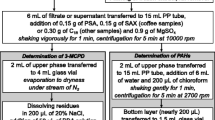Abstract
The presence of nitrated polycyclic aromatic hydrocarbons (nitro-PAHs) as contaminants in foods is nowadays a legitimate cause of concern, as they are reported to be strong direct-acting mutagens and carcinogens that may pose a risk to human health. Nevertheless, their concentrations in foods are in the ultra-trace region. In this study, we present a very sensitive analytical method for the determination of this compound class in complex food matrices. Special emphasis was put on sample extraction and clean up. Recoveries of 75% could be obtained for 1- and 2-nitronaphthalene; for all other compounds investigated the recoveries were ≥94%. The determination of the compounds was performed by gas chromatography–mass spectrometry. The results show that the use of negative chemical ionization (NCI) increases the sensitivity by one order of magnitude in comparison to electron impact ionization (EI) (limits of detection 0.07–0.25 µg kg−1 for EI and 0.01–0.02 µg kg−1 for NCI). The influence of the sample matrix on the sensitivity of the method is demonstrated with extracts of a sample from a duplicate diet study. Due to the lack of a certified reference material the suitability of the method is demonstrated with pumpkin seed oil that was spiked with nitro-PAHs at two different concentration levels.



Similar content being viewed by others
References
IARC Monograph (1989) 46:321–373
Fu PP (1990) Drug Metab Rev 22:209–268
Grosovsky AJ, Sasaki JC, Arey J, Eastmond DA, Parks KK, Atkinson R (1999) Res Rep HEI 24:1–22
Scheepers PTJ, Velders DD, Martens MHJ, Noordhoek J, Bos RP (1994) J Chrom A 677:107–121
Spitzer T (1993) J Chrom 643:43–49
Pitts JN Jr (1987) Atmos Environ 21:2531–2547
Arey J (1998) Handbook Environ Chem 3 (Pt I):347–388
Larsson BK, Pyysalo H, Sauri M (1988) Z Lebensm Unters Forsch 187:546–551
Dennis M, Massey RC (1984) Food Addit Contam 1:29–37
Kinouchi T, Tsutsui H (1984) Mutat Res 171:105–113
Schlemitz S, Pfannhauser W (1996) Z Lebens Unters Forsch 203:61–64
Schlemitz S, Pfannhauser W (1996) Food Addit Contam 13:969–977
Schlemitz S, Pfannhauser W (1996) Z Lebens Unters Forsch 203:61–64
Ziegler W, Garcia–Penalver L, Preiss U, Wallnoefer PR (1999) Adv Food Sci 21:54–57
Dafflon O, Scheurer L, Koch H (2000) Mitt Gebiete Lebensm Hyg 91:158–171
White CM (ed) (1985) Nitrated polycyclic aromatic hydrocarbons. Huethig Verlag, Heidelberg Basel New York
Dimashki M, Harrad S (2000) Atmos Environ 34:2459–2469
Jinhui X, Lee FSC (2001) Chemosphere 42:245–258
Tejada SB, Zweidinger RB (1986) Anal Chem 58:1827–1834
Liu TY, Robbat A Jr (1991) J Chrom 539(1):1–14
Specht W, Tillkes M (1980) Fresenius J Anal Chem 301:300–307
Funk W, Damman V, Donnevert G (eds) (1992) Qualitätssicherung in der Analytischen Chemie. VCH, Weinheim
Acknowledgement
This work was supported financially by the Austrian Ministry of Education, Research and Culture as well as by the European Commission (INCO-Copernicus project ERBIC 15 CT98 0339). The authors would like to thank the research group from the Institute of Chemical Technology, Department of Food Chemistry and Analysis, Prague, Czech Republic (Prof. Jana Hajslova, Bohuslav Dusek, Vladimir Kocourek) for the fruitful discussions within the project as well as Prof. Martin Mittelbach, Institute for Organic and Bioorganic Chemistry, Graz University, Austria for providing the possibility to use GC-MS-NCI.
Author information
Authors and Affiliations
Corresponding author
Rights and permissions
About this article
Cite this article
Siegmund, B., Weiss, R. & Pfannhauser, W. Sensitive method for the determination of nitrated polycyclic aromatic hydrocarbons in the human diet. Anal Bioanal Chem 375, 175–181 (2003). https://doi.org/10.1007/s00216-002-1653-8
Received:
Revised:
Accepted:
Published:
Issue Date:
DOI: https://doi.org/10.1007/s00216-002-1653-8




